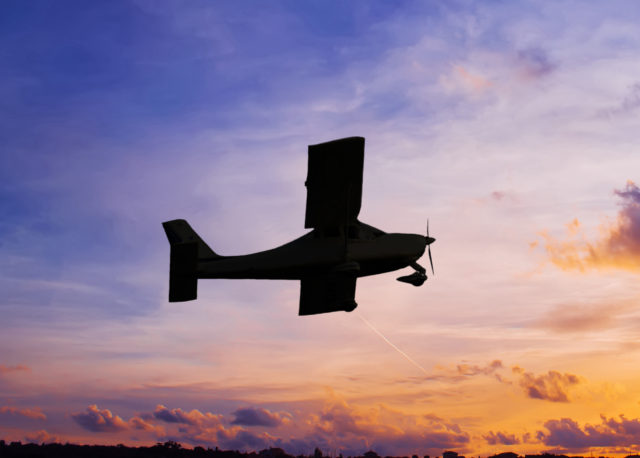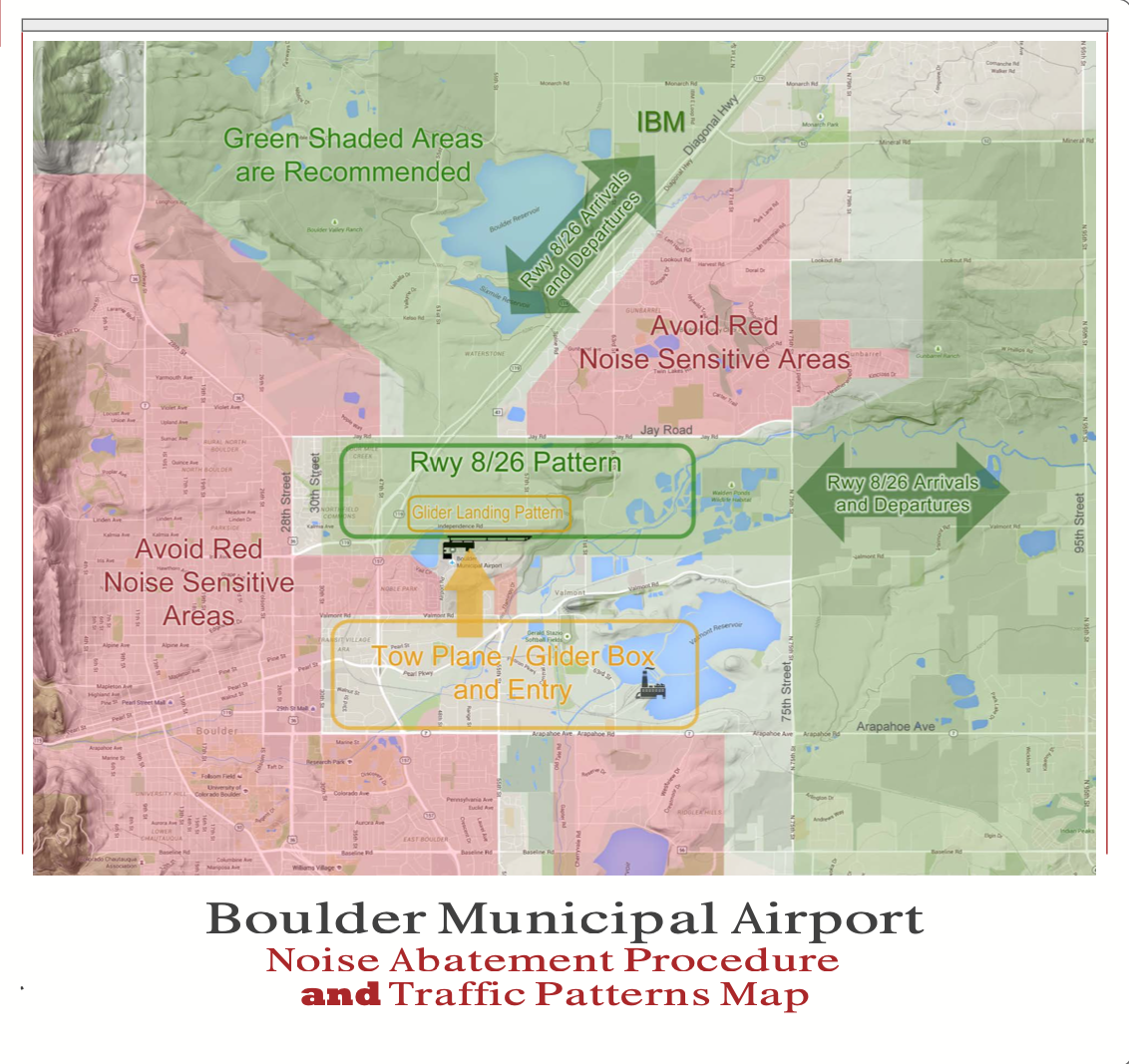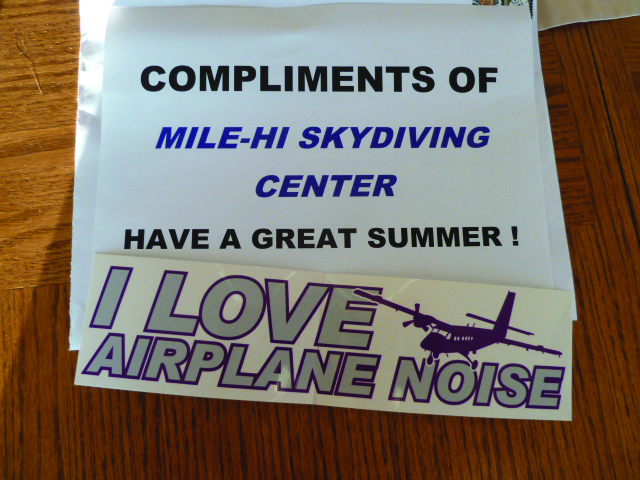
The droning buzz of low-flying propeller aircraft circling over David Segal’s house won’t stop, he says. The sound of their engines is an all-but constant part of his life in North Boulder and it’s driving him and other residents to their wits’ end.
“It’s like having a lawn mower flying over your house all day,” Segal, who lives in proximity to Boulder Municipal Airport (BMA), and who’s a member for the Boulder “Quiet Skies” Facebook group, says. “There are literally days when you can’t sit outside and enjoy the outdoors because of the constant droning of these planes.”
In 2005, BMA recorded 59,400 operations (takeoffs or landings) annually, according to the city of Boulder’s 2007 BMA masterplan. That number was projected to approach 85,000 annual operations by 2023—roughly 233 per day. In 2007, approximately 73% of those were categorized as “local operations,” consisting of flight training, touch-and-go operations (where pilots practice flying around an airport, touching down and taking off in circuits) and recreational flying. The remaining 27% are aircraft stopping in for short periods, for business or transportation.
That’s a lot of airplane traffic no matter how you slice it—especially considering that BMA shares airspace over Boulder County with a dozen local flight schools and both Longmont Municipal Airport (LMA) and Rocky Mountain Metropolitan Airport (RMMA) in Broomfield.
“They fly loops . . . They fly low . . . And they fly over the same area for five or 10 minutes or more. Just circling,” Segal describes. He says it’s a risk to public health. Not just because the noise is testing people’s sanity, but because those planes are burning lead fuel over the communities below.
Some residents and activists in the Quiet Skies group even attest that they’ve been directly targeted and harassed by retributive pilots who are frustrated by individuals lodging frequent noise complaints.
Many Boulder residents living in designated “noise sensitive” areas might be surprised to learn airplane noise is such a problem in Boulder. But for two very invested and divergent groups, this is an extremely heated subject. For local homeowners in “recommended” flight areas, such as Segal, this is an issue of mental and physical health and an affront on their sanctuary. For the pilots flying over those residents, it’s a matter of livelihood (or training to gain one).

Morgan Katnik, the assistant manager at Journeys Aviation, a flight school based out of BMA, says they’re just doing their jobs, operating within the rules of the Federal Aviation Administration (FAA) and following Boulder County’s noise abatement protocols—which are voluntary.
“A lot of our neighbors don’t know the specifics of the noise abatement guidance nearly to the level that the pilots here do,” Katnik says. “There’s got to be some education element between the city of Boulder and the residents who are complaining about airplane noise.”
The policy Katnik references stipulates where planes should fly to avoid dense neighborhoods or parts of Boulder, outlines what engine RPMs are ideal and at which altitudes, recommends that pilots avoid touch-and-go training before 8 a.m. and after 5 p.m., and requests no flight operations whatsoever between 11 p.m. and 7 a.m.
These procedures are highly encouraged by BMA, but if a pilot strays over “noise sensitive” areas, or practices training maneuvers at an odd hour of the night or morning, as long as they aren’t breaking any FAA rules they have every legal right to do so. BMA can’t do much to change that, without refunding the FAA millions of dollars or shutting down entirely.
As John Kinney, the airport manager for BMA, explains, BMA, like most municipal airports in the U.S., receives grants and funding through the FAA’s Airport Improvement Project (AIP). Those funds pay for necessary maintenance and upgrades for runways, taxiways, markings, signage, and so forth. Any airport participating in the AIP has to follow the FAA’s rules and regulations to a T—and the FAA has some very strict and very clear rules forbidding local airports from regulating their own noise.
“Noise abatement in a community surrounding airports is very complicated, and a challenging situation,” Kinney says. “I’ve spent a lot of time with this topic and Boulder Municipal Airport has a lot of room for improvement.”
Kinney is new to BMA, but has been in the aviation industry since the ’80s and has worked at some of the “most noisy, contentious airports in the nation,” he says. He has decades of experience with this problem, and he’s got some progressive ideas for improving the situation in Boulder. He notes, though, that the simple fact this issue has been ongoing around the country for over 40 years speaks to its Gordian nature.
Kinney says that back in the ’80s and ’90s, airports around the country all had their own noise abatement regulations. Back then, communities got to dictate their own rules for how air traffic could operate in their air space. Sometimes that meant permanent noise monitoring and single event maximum noise limits, closing the airports at night, or banning certain types of operations, like touch-and-go training.
That caused confusion for pilots, who often visit between two and seven cities in a day across the country, and created unnecessary air chaos in more than a few instances.
“The FAA became fatigued,’” Kinney says, “and they said, ‘No more. This is compromising safety.’’’
It led, eventually, to the creation of the FAA’s standardized Aviation Noise Abatement Policy around the year 2000, Kinney says. That policy did away with local noise abatement regulations and it prohibited local airports from creating, implementing or instituting any operational changes based on noise at any airport accepting AIP grants.
“That uniformity is the safety feature that the FAA has built into the system. So we no longer have this hodgepodge of noise abatement programs,” Kinney says. “It’s all the same now.”
In the last 10 years, BMA has accepted around $8 million through the FAA’s AIP. Kinney says the airport received one grant last year for a runway overlay, and another just weeks ago as part of the COVID relief package. Those grants come with grant assurances that the airport has to deliver on—terms and conditions that govern how an airport can operate—and they last for 20 years beyond the date of acceptance.
“So each one of those that we receive . . . starts the clock over for 20 years,” Kinney says, meaning that BMA has to follow the FAA’s noise abatement rules for at least two more decades. And unless BMA and the city of Boulder agree to start funding all future improvements out of pocket, there are few options for mandating noise regulations.
However, pilots like Christina Montgomery, a flight instructor at Journeys Aviation, say they’re doing their best to adhere to Boulder’s noise abatement policies and to avoid flying over people’s homes. Montgomery says noise abatement is one of the first things she teaches her students at Journeys Aviation. She maps out where noise sensitive areas are and encourages aspiring pilots to avoid them as best they can. She encourages other pilots to do the same.
“Those of us that are based here and fly here, we do actively tell people on the radio if we notice they are [flying in] noise sensitive areas,” Montgomery says. It’s in Journeys’ best interest as an aviation company to make sure everyone is following the rules, she says.
Beyond annoying noises, some residents point out that heavy air traffic poses other hazards to a community. Former Gunbarrel homeowner Kim Gibbs says that unlike commercial airliners, the types of aircraft flying over Boulder County burn a fuel that has been banned in cars in the U.S. since 1996.
“Piston engine aircraft run on leaded aviation gas, and it’s spewing airborne lead all around, oftentimes landing on children’s schools and nearby properties that are near the airport,” Gibbs, who advocates nationally for the Quiet Skies group, says. “It is a health and wellbeing issue.”
One MIT paper published in the journal Environmental Science and Technology in 2016, titled, “Costs of IQ Loss from Leaded Aviation Gasoline Emissions,” supports that claim. That study found IQ losses resulting in roughly $1 billion in damages from lifetime earnings reductions, and $500 million in economy-wide losses from decreased labor productivity.
Another study, commissioned by the Reid-Hillview airport in Santa Clara, California, explored how lead aviation fuel affects children in proximity to that airport. The study found a statistically significant relationship between exposure to aviation gasoline and lead levels in the blood of children, concluding, “The ensemble evidence compiled in this study supports the ‘compelling’ need to limit aviation lead emissions to safeguard the welfare and life chances of at-risk children.”
As a result of that study, the Reid-Hillview and nearby San Martin Airports ceased the sale of lead aviation gas.
“For people who [spend a lot of time] outside, it’s something that they really should pay attention to,” Gibbs says. “A lot of people don’t realize that.”
Gibbs moved from Gunbarrel out of state several years ago. Not just because of airplane noise, but in large part because of it, she says. She and her husband had bought a home in 2006 adjacent to 100 acres of open space. But as the airports got busier and as more flight schools opened up, their once peaceful neighborhood was submerged in noise.
She formed the group Citizens for Quiet Skies in 2011 as part of the National Quiet Skies Coalition. She started consistently lodging noise complaints, writing representatives, using flight tracker apps to identify planes and out their owners. And eventually, Gibbs noticed that one company in particular was making a lot of noise over her home—a skydiving company out of Longmont based at LMA: Mile-Hi Skydiving Center. Not only was this company flying a very loud twin propeller airplane (known as a Twin Otter), but it seemed to be flying over her neighborhood with increasing frequency and, seemingly to her, deliberacy.
“Our home was heavily targeted by rogue pilots,” she says. “That’s not to say that all pilots are that way, but it doesn’t take a lot of them to target you and make your life absolutely miserable.”

A mailer received by members of the Quiet Skies group, allegedly from the Mile Hi Skydiving Center. Courtesy Kim Gibbs.
As Gibbs’ noise complaints continued and as the Quiet Skies group grew, tension escalated. In 2012, she says members of the group received a mailer, “Compliments of Mile-Hi Skydiving,” that included a bumper sticker featuring the outline of a Twin Otter and the words “I LOVE AIRPLANE NOISE.” Gibbs shared documentation with BW showing that she was doxxed online: her name and home address were posted to pilot forums; Facebook users would comment on her posts, threatening to buzz her home and promising to do flyovers if they were ever in the area. She got threatening voicemails from people claiming to be pilots or FAA officials.
Other members of the Quiet Skies group say they experienced this too. Lafayette resident Bri Lehman also believes she was targeted after filing noise complaints against local aviation companies.
Gibbs’ situation got to a point in 2015 where she and other members of Quiet Skies sought legal action against Mile-Hi Skydiving Center. During the court case, one of Mile-Hi’s own pilots testified that he had been in the cockpit with the company’s owner, Frank Cacares, when he “pointed out where her house was and proceeded to do repeated circles over it,” the court transcript reads.
“He flew differently than the standard or typical climb sequence or descent sequence that we operated during alones . . . He descended in a props forward condition, meaning propellers in a fine pitch condition which yields higher noise,” the pilot, Andrew Hill testified. “His exact comment, if I do recall, was, ‘Hello Kim, hoping you’re having a nice evening.’”
Despite that testimony and Gibbs’ other evidence of targeted harassment, the judge sided with Mile-Hi, concluding that they had not broken any FAA rules and that the plaintiffs’ accusations of nuisance and negligence were unfounded.
Mile-Hi Skydiving Center did not respond to multiple attempts by phone and email for comment.
“That would be very concerning behavior,” Kinney, BMA’s airport manager says. “And it’s not the type of behavior that we would want at the Boulder Airport under any circumstances. That should be turned over to the FAA, and there’s a threshold where law enforcement should be involved as well . . . that maybe should have been turned over to the police department.”
Kinney says that with pilots, just like in any industry, you can have “bad apples.” But he is confident that no one operating out of BMA is targeting homes to harass individuals who file noise complaints. Most pilots want to fly quietly, he says. Both Montgomery and Katnik agree, asserting that pilots often have good reasons to make circles in the air. Sometimes simply to put more space between themselves and the pilot flying in front of them along the same flight path.

Lafyette resident Bri Lehman recorded the flight path of an airplane flying circles over her home under the required altitude of 1,000 feet. She lodged a complaint of targeted harassment, but pilots argue these are standard training maneuvers.
“No one flying and no one taking flight lessons here out of the Boulder Airport is flying over someone’s house intentionally for the purpose of being loud to them,” Katnik says.
They’re not out there flying with malice, Montgomery says. That’s a surefire way to get more noise complaints filed, and it could even put your pilot’s license at risk, she says—which for many pilots is their livelihood.
So what can be done? How can community members living near airports like BMA, LMA and RMMA, living within “recommended” flight areas, coexist with the airports near their homes? Predictably, both sides of the argument have their own ideas.
Gibbs suggests instituting landing fees that would make touch-and-go flights preventatively expensive. But Montgomery and Katnik argue that wouldn’t stop most pilots from flying—it would only further price out people of lesser means, minorities and females from becoming pilots in Boulder County.
Segal suggests moving the touch-and-go traffic elsewhere, where fewer people live. Though even he admits that would only push the problem over other people’s homes and it would use more gas in the process.
The National Quiet Skies Coalition advocates for a robust community engagement process for all new flight paths or changes to existing flight paths, and wants to mandate the FAA permit and fund noise mitigation.
For his part, as director at BMA, Kinney has some progressive ideas as well. He recognized early on how hard it was for community members to lodge noise complaints with the airport, so on April 1, BMA rolled out a noise abatement hotline specifically for that purpose (303-441-4000). BMA is also launching its very own airplane tracking system online, reporting data in real time. Additionally, he’s considering installing cameras on the runway, so anyone can check in and see what’s going on at the airport.
He adds that unleaded aviation fuel is being pursued “aggressively” by the FAA and by airports around the country, and many operators like Journeys Aviation plan on switching over to it as soon as it’s officially approved by the FAA.
But the single most important way to address airplane noise in Boulder County is to create a dialogue between the two contending groups, Kinney says—to get the pilots and concerned homeowners in the same room and to cultivate a civil discourse between them.
“It would be [productive] to help bridge the two groups together because I think they’re so far apart right now,” Kinney says. “I think everybody would be happier if we could get them all together and just get creative as opposed to contentious.”














